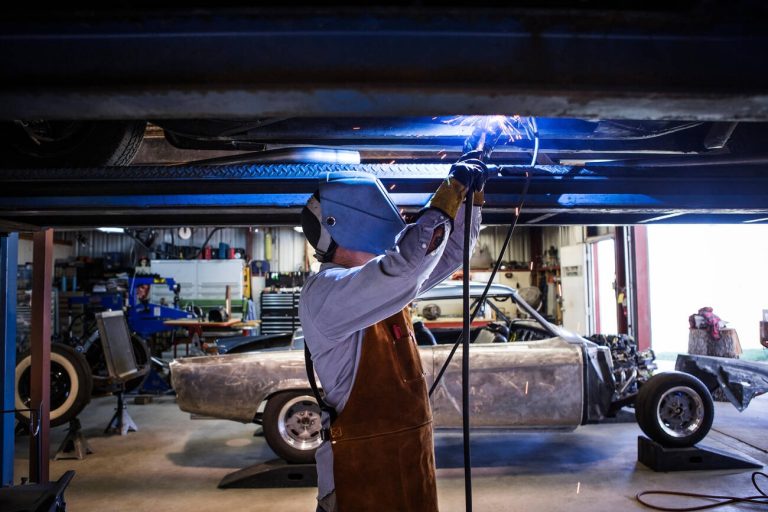Blacksmithing is a craft that has stood the test of time, with roots stretching back centuries. While the tools and techniques have evolved, the need for proper protective gear has remained constant. Among the most critical pieces of equipment for any blacksmith is a sturdy, reliable apron. This article will explore the world of Best Aprons in blacksmithing, emphasizing their importance, key features, and how to maintain them. We’ll also highlight why investing in a quality leather apron is essential for both novice and seasoned blacksmiths alike.
The Importance of a Leather Apron in Blacksmithing
Protection from Heat and Sparks
Blacksmithing involves working in an environment filled with intense heat, flying sparks, and hot metal shards. A leather apron serves as a vital shield, protecting the body from these hazards. Leather, with its natural heat resistance, is ideal for this purpose. It can withstand the extreme temperatures and sparks typical in a forge, providing a reliable barrier against burns and injuries.
Unlike synthetic materials, leather is less likely to catch fire or melt when exposed to sparks or molten metal. This inherent flame resistance makes leather aprons a safer choice for blacksmiths, who often work in close proximity to open flames and red-hot metal.
Barrier Against Debris and Dirt
The forge is a messy environment, filled with soot, dust, and metal shavings. A leather apron acts as a robust barrier, protecting clothing and skin from these elements. Over time, the apron itself becomes a testament to the hours spent at the anvil, with every scratch and stain telling a story of hard work and craftsmanship.
Leather aprons are particularly effective at keeping dirt and debris at bay. The material’s thickness and durability ensure that it can handle the rigors of blacksmithing without wearing down quickly. Additionally, leather is relatively easy to clean, making it a practical choice for those who spend long hours in the forge.
Enhanced Focus and Confidence
A well-fitting leather apron not only provides protection but also boosts a blacksmith’s confidence. When a blacksmith knows they are adequately shielded from the dangers of the forge, they can focus more on their work. This confidence is crucial for achieving the precision and creativity required in blacksmithing.
Moreover, a leather apron adds a level of professionalism to a blacksmith’s appearance. Whether working alone in a home forge or demonstrating skills at a public event, a clean, well-maintained leather apron reflects pride in one’s craft.
Essential Features of a Quality Leather Apron
Material: The Superiority of Leather
Leather has long been the material of choice for blacksmithing aprons due to its unique properties. It is tough, durable, and naturally resistant to heat and sparks. A high-quality leather apron can last for years, even with daily use, making it a worthwhile investment for any blacksmith.
Thickness and Durability
When selecting a leather apron, thickness is a key factor. The thicker the leather, the more protection it offers. However, thicker leather can also be heavier and less flexible, so it’s essential to find a balance between protection and comfort. Ideally, a leather apron should be thick enough to protect against sparks and heat but still flexible enough to allow for freedom of movement.
Durability is another crucial aspect of a leather apron. Look for aprons made from full-grain or top-grain leather, which are the most durable and resistant to wear and tear. Full-grain leather, in particular, is the highest quality, as it retains the natural grain and imperfections of the hide, adding to its strength and longevity.
Design and Comfort
The design of a leather apron is just as important as the material. A well-designed apron distributes its weight evenly, reducing strain on the neck and shoulders and allowing the blacksmith to work comfortably for extended periods.
Strap Design: Cross-Back vs. Neck Strap
The strap system is a critical element of apron design. Leather aprons typically come with either neck straps or cross-back straps.
- Neck Straps: Traditional aprons often feature a neck strap, which can be quick to put on and take off. However, for heavier leather aprons, this design can place too much pressure on the neck, leading to discomfort over time.
- Cross-Back Straps: Cross-back straps are increasingly popular because they distribute the apron’s weight across the shoulders and back rather than focusing it on the neck. This design is generally more comfortable, especially for blacksmiths who wear their aprons for long periods. Cross-back straps also help keep the apron in place, reducing the need for adjustments during work.
Fit and Adjustability
A quality leather apron should offer a customizable fit. Adjustable straps, particularly those for the waist and shoulders, allow the blacksmith to tailor the apron to their body, ensuring maximum comfort and mobility. Quick-release buckles can be a practical feature, making it easier to put on and remove the apron as needed.
The length and width of the apron are also important considerations. A longer apron provides more coverage and protection, particularly for the legs, but may restrict movement. Conversely, a shorter apron offers greater mobility but less protection. Finding the right balance is essential for ensuring both safety and comfort in the forge.
Reinforcement and Durability
Blacksmithing is a demanding craft, and aprons are subjected to constant wear and tear. A well-made leather apron is built to last, with reinforced stitching, extra layers in high-wear areas, and durable materials that can withstand the daily challenges of the forge.
- Reinforced Stitching: Look for aprons with double or triple stitching in areas that experience a lot of stress, such as the seams, straps, and pockets. Reinforced stitching prevents the apron from coming apart over time, even with heavy use.
- Extra Layers: Some leather aprons feature extra layers in key areas, such as the chest and thighs, to provide additional protection and durability. These layers can significantly extend the life of the apron, making it a more economical choice in the long run.
Choosing the Right Leather Apron for Your Needs
Consider Your Experience Level
The type of apron you need may depend on your experience level and the type of work you do.
- For Beginners: If you’re new to blacksmithing, a mid-weight leather apron that balances protection and mobility may be ideal. It provides sufficient protection while allowing you to move freely and get comfortable with the craft. Adjustable straps are important for ensuring a proper fit as you gain experience and work on more complex projects.
- For Experienced Blacksmiths: If you’ve been blacksmithing for a while and are tackling more demanding projects, consider investing in a heavier, more protective apron. A full-grain leather apron with reinforced stitching and cross-back straps can provide the durability and comfort needed for long hours at the forge.
Understanding Your Work Environment
The environment in which you work can influence your choice of apron. For example, blacksmiths working in outdoor settings may need an apron that can withstand exposure to the elements, while those working indoors may prioritize comfort and mobility.
- Indoor vs. Outdoor Work: If you primarily work indoors, you might prefer a lighter leather apron that allows for easier movement. On the other hand, if you work outdoors, where you’re exposed to wind, rain, and other elements, a heavier, more robust apron might be a better fit. Leather is naturally resistant to moisture, but it’s still important to regularly treat it with conditioners to prevent drying and cracking.
- Type of Forge: The type of forge you use—whether gas or coal—can also affect your apron choice. Coal forges tend to produce more sparks and debris, so a thicker, more protective apron may be necessary. Gas forges, while still hot, may produce fewer sparks, allowing for a slightly lighter apron.
Balancing Protection and Mobility
Finding the right balance between protection and mobility is essential when choosing a leather apron. While thicker leather provides better protection, it can also be heavier and more restrictive. Conversely, lighter leather allows for greater freedom of movement but may offer less protection.
Consider the type of work you do and how much mobility you need. If you often work with large pieces or move around the forge frequently, a lighter apron may be more practical. However, if you spend most of your time at a stationary anvil and require maximum protection, a heavier apron might be worth the trade-off in mobility.
Maintaining Your Leather Apron
Cleaning and Care
Proper maintenance is crucial for keeping your leather apron in good condition and ensuring it continues to provide adequate protection. Leather requires regular cleaning and conditioning to remain supple and resistant to cracking.
- Cleaning: After each use, wipe down the apron with a damp cloth to remove dirt, soot, and metal shavings. Avoid using harsh chemicals or soaking the leather in water, as this can damage the material.
- Conditioning: Periodically, apply a leather conditioner to keep the leather soft and flexible. Conditioning helps prevent the leather from drying out and cracking, which can compromise its protective qualities.
- Storage: When not in use, hang the apron on a sturdy hook or hanger to prevent creases and wrinkles. Store it in a cool, dry place away from direct sunlight to avoid fading and drying out.
Repairing Minor Damages
Even the best leather aprons can experience wear and tear over time. Addressing minor damages promptly can prevent them from becoming more significant issues.
- Torn Straps: Straps are often the first part of a leather apron to wear out. If a strap becomes torn or frayed, repair it as soon as possible. Depending on the severity of the damage, you may be able to sew it back together or replace it entirely.
- Worn Seams: Seams can also become worn over time, particularly in high-stress areas. Reinforce worn seams with additional stitching to extend the apron’s lifespan.
The Evolution of Leather Aprons in Blacksmithing
Historical Perspective
Leather aprons have a long history in blacksmithing, dating back to the earliest days of the craft. In ancient times, blacksmiths wore simple cloth aprons for protection, but as the craft evolved, leather became the material of choice due to its durability and resistance to heat and sparks.
In the Middle Ages, Blacksmith Leather Apron became more common, with blacksmiths recognizing the material’s superior protective qualities. These early aprons were often made from thick, durable leather and featured simple designs with a neck strap and waist tie. As blacksmithing became more specialized, aprons began to evolve, incorporating additional features such as reinforced areas and multiple straps for better weight distribution.
Modern Innovations
Today, leather aprons remain a staple in blacksmithing, but they have evolved to meet the needs of modern craftsmen. Advances in leatherworking have led to the development of aprons that are not only durable and protective but also comfortable and customizable.
Modern leather aprons often feature ergonomic designs with cross-back straps, adjustable fits, and reinforced stitching. Some aprons, like those offered by Lapron, even allow for customization, enabling blacksmiths to choose the features that best suit their needs.
Why Investing in a Quality Leather Apron Matters
Safety First
The primary reason to invest in a quality leather apron is safety. Blacksmithing is a hazardous craft, and a well-made leather apron provides essential protection against burns, cuts, and other injuries. By choosing a high-quality apron, blacksmiths can work confidently, knowing they are shielded from the dangers of the forge.
Long-Term Value
A quality leather apron is a long-term investment. While it may cost more upfront, its durability ensures that it will last for years, saving money in the long run. Moreover, a well-maintained leather apron provides consistent protection, making it a reliable choice for any blacksmith.
Professional Appearance
Finally, a quality leather apron contributes to a professional appearance, which is important for blacksmiths who sell their work or demonstrate their skills. A well-maintained, clean apron reflects pride in one’s craft and attention to detail, both of which are essential qualities in any profession.
Conclusion
Choosing the right leather apron is a crucial decision for any blacksmith. It’s about more than just protection—it’s about comfort, durability, and presenting oneself as a skilled and professional craftsman. Whether you’re a beginner or a seasoned blacksmith, investing in a quality leather apron like those offered by Lapron will enhance your safety, productivity, and overall experience in the forge. Properly caring for your leather apron will ensure it continues to serve you well for years to come, allowing you to forge on with confidence and style.
FAQs
What makes Lapron aprons ideal for blacksmithing?
Lapron aprons are designed with durable, heat-resistant materials that provide excellent protection against sparks and hot metals, making them perfect for blacksmithing.
Are the aprons adjustable for different body sizes?
Yes, the aprons are fully adjustable, ensuring a comfortable fit for men of all sizes.
How do I clean my Lapron blacksmithing apron?
Cleaning instructions vary depending on the material, but generally, you can wipe it down with a damp cloth. For tougher stains, follow the care label attached to the apron.
Can these aprons be used for other types of metalwork?
Absolutely! These aprons are versatile enough for welding, metal fabrication, and other heavy-duty work.
Do Lapron aprons come with pockets?
Yes, many of our aprons include pockets for convenient storage of tools and small items while you work.








